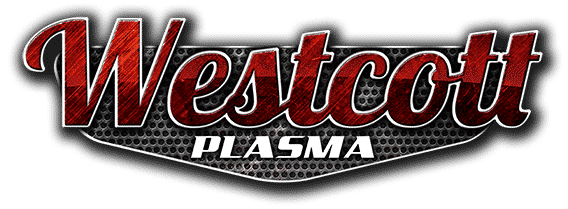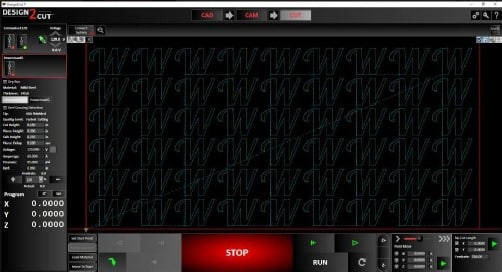You’re going to need a few things to get started in the CNC Plasma Cutting business or Hobby. The basics are the same for someone that will be doing this as a hobby or as a full time business. I will go over the basics here and you can follow the links to get more specific info on each of the items.
There has never been more options, as far as tables and equipment, than there is now. When I started, there were only a handful of companies that built tables or components.. now there are thousands. Sorting through all of this can be a challenge and even overwhelming at times. I will help you sort through the options and find the best setup for your application.
Cost
Price varies from around 5K to over 200K and everywhere in between. One of the factors that determine cost is the size of the machine, which can be a super small 2×2 ft table to a 6x20ft table or larger. The most common sizes for hobby and light industrial tend to be: 4×4, 4×8 and 5×10 feet. Many people start out with a 4×4 table because it is usually the least expensive, but quickly outgrow the table and want to make bigger things or more of something without having to load more material. Common steel sheet sizes are 4×8 feet and 5×10 feet. Which is why you see table sizes to match.
When I first got started, I fully intended this to be a garage hobby but it quickly grew into a full time business. Trying to anticipate future needs and wants is critical and can save you a lot of money in the long run. I get a lot of people who ask me what size they should buy, and I usually try and discourage them from a 2×2 or 4×4. More often than not, they quickly outgrow these smaller tables. Going one size bigger than you think is often a safe bet. Prices from a 4×4 to a 4×8 are usually not much different, because the cost of the other components to run the machine remain the same.
The basic components of a CNC Plasma System
The Cutting Table
This is where your material is going to go and be cut. Common variations are sizes 2×2, 4×4, 4×8 and 5×10. Other variations are: Water tables which have water under the cutting surface. This helps to eliminate smoke and dust, as well as keep the parts cool and minimize warping. Downdraft tables use exhaust fans to pull the smoke and dust down and exhaust it outside of the work area, and then open tables, which are the least expensive, and have nothing below them but ground. We will discuss all of these in the plasma table section.
Plasma Cutter
This is the piece of equipment that is actually cutting the metal. It uses electricity to generate the plasma arc and cut through the metal. Plasma Cutters are most often classified by Amps. Common Amp ratings are 45, 65, 85, etc. There are quite a few companies that make plasma cutters but many are not specifically designed for mechanized cutting. They can usually be retrofitted and made to work. This is one piece of equipment that is critical to the quality of the cuts. Skimping here often results in regret down the road. Check out the plasma cutter section for more detailed information.
Software
There are a few software components that make up a plasma system. There is the design software, where you make your part in a CAD (Computer Aided Drafting) program. This is usually in a program like Corel Draw, Adobe Illustrator, Design2Cut or a host of other programs. Once your part has been created, you export this file in a CAD format with the file extension .dxf (unless you use Design2Cut, an all-in-one software). Once you have this file format, you can open the file in a CAM (Computer Aided Manufacturing) program. This program is where you set up what material you’re cutting, where to start, what to cut and all of the cutting parameters. Once you have completed the CAM step, you then export the file out in a file extension .tap. This is your G-Code (Machine Language). This code tells the machine where to go, how fast, how long, how many amps to use, and directs the operation of the torch and your table. There are a lot of choices in the world of software and I will cover them in depth in the CNC software section.
Compressed Air Source
Air, not oxygen or any other special gas, is the most common gas used in plasma cutting. There are special industrial grade units that use Oxygen, Argon, Nitrogen, and Hydrogen in the cutting process (High Definition Plasma Table, or Precision Plasma). On this post, we will mainly be focusing on air plasma cutting machines and air plasma tables. Air Plasma units only need you to supply them two things to cut metal – Air and Electricity. Most plasma machines need a supply of around 100 PSI to make this all happen. It’s critical to the quality of the cut that the air delivered to the plasma cutter be as clean and dry as possible. We will cover all of this in the CNC plasma cutting section.
Power
Power is one of the critical components that makes plasma cutting happen. You will need power to run the computer, control system and table drive system.. as well as power for the Plasma Cutter. Most plasma tables only require 120v connections. Most plasma cutters, on the other hand, require a minimum of 240v Single Phase to power them. The larger the plasma cutter (more amps) equals more cutting capacity and requires more amps to make the larger cuts. Larger industrial and high definition plasma units will require 3 phase power.
It is critical that you carefully evaluate the power requirements of the plasma cutter you are considering and look at the manufactures listed amp and circuit breaker requirements for the unit. Many small shops and garage based shops may not have the electrical wiring to support the larger plasma machines and may require expensive electrical upgrades. Make sure you evaluate the manufactures recommendation on the plasma unit you are considering, and discuss this with a qualified electrician.
We will discuss the plasma cutters in greater depth in the plasma cutter section.
Computer
You’re going to need a computer for all of this to work, and often two of them. Most software and plasma table manufacturers will recommend that you have one dedicated computer to run the the machine, and only have the software necessary to run the machine on it. You don’t want to be surfing the Internet and playing games on the computer that is running the machine.
Computers have so many things going on in the background. The more programs you add to the machine, the more likely you are to have things running in the background. These background operations can disrupt and interfere with the cutting operation of your machine and ruin your plasma cutting projects. There are plenty of people who risk it and do everything on one machine. Some are lucky and some are not. I have always kept my machine computer dedicated to machine operation. It’s safer and a better option.
The computer running the machine does not need to be a high end gaming PC. The machine requirements are pretty basic. Different plasma cutting machines have different computer requirements. Most plasma table manufacturers will advise or supply the needed computer for the machine side of the operation. If building your own system from scratch, you can often use a refurbished dell to make it work. Be sure to check with the plasma table manufacturer or control system manufacturer before purchasing a computer. This way, you get one that works for your application.
Many times, manufacturers do not recommend laptops for the machine computers due to several internal configuration settings seen in laptops. Your second computer will be the computer that you do all of your part or artwork design on. This tends to be your higher end computer, to handle the graphics and CAD operations. Once you have created your project on this compute,r you can export the finished G-Code over to your machine computer via Wifi, Ethernet (Home or work Network) or a simple USB thumb drive. I have my CAD software loaded on a laptop and my office computer to allow me to design anywhere I want. I will cover software more in depth in the CNC Plasma Cutting Software section.
Control System
Your control system is best described as a box containing circuit boards and driver units. This takes the computer code that was created in the software and turns it into electrical signals. The signal then tell the Stepper Motors or Servo motors where to go when and how fast. Steppers and Servos are the motors that drive the gantry and your torch around the table. There is quite a bit of debate over Stepper vs Serv,o and you can get more info in the CNC plasma tables section. This control system box and all of the internal components vary from manufacturer to manufacturer. There are control systems that are exclusive to plasma table manufacturers and are sold with the table as a package. There are also companies that make DIY packages, allowing you to build your own table.
Turnkey Plasma Table System vs. Build your own or Kit system
This is another highly debated topic. One which has pluses and minuses on both sides. There are hundreds of turn key plasma table solutions offered today. A turn key option is one where you can purchase everything you need in one shot, ready to cut. Everything is configured and ready to go. All you do is supply air and power, then you’re off and running. Advantages include faster, simpler, less of a learning curve, less to go wrong, no compatibility problems between components, one point of contact if something does go wrong. The only real disadvantage is price. You are going to pay for all of this convenience with a higher price tag.
Kit or Build your own systems are almost always less expensive than turnkey, but all the advantages of a turnkey system can now be disadvantages of a build your own or kits system. With a build your own system, you have the ability to control the quality and components at every step of the project. You will be able to gain a great deal of knowledge about the inner workings of your system, and likely fix problems on your own if they come up. Building your own will require skill and precision. Having a table that is not square, or that has problems, will affect your products quality and appearance.



